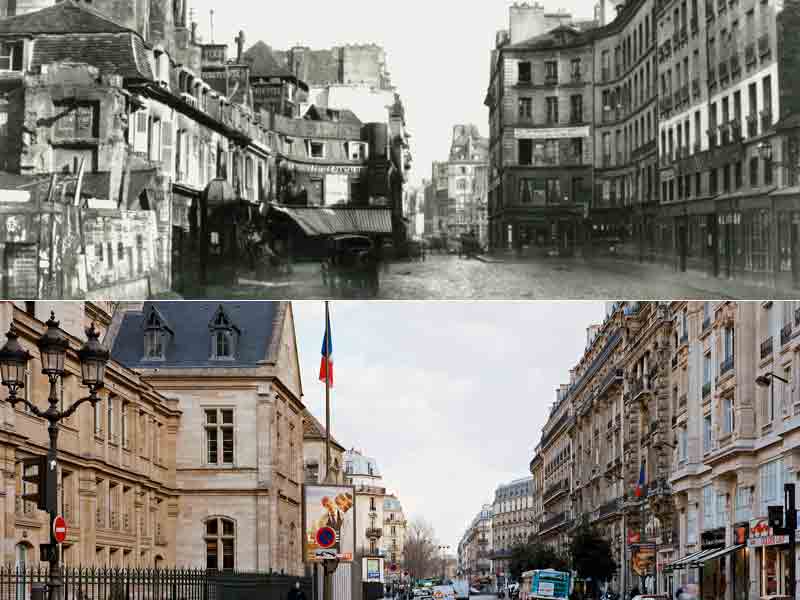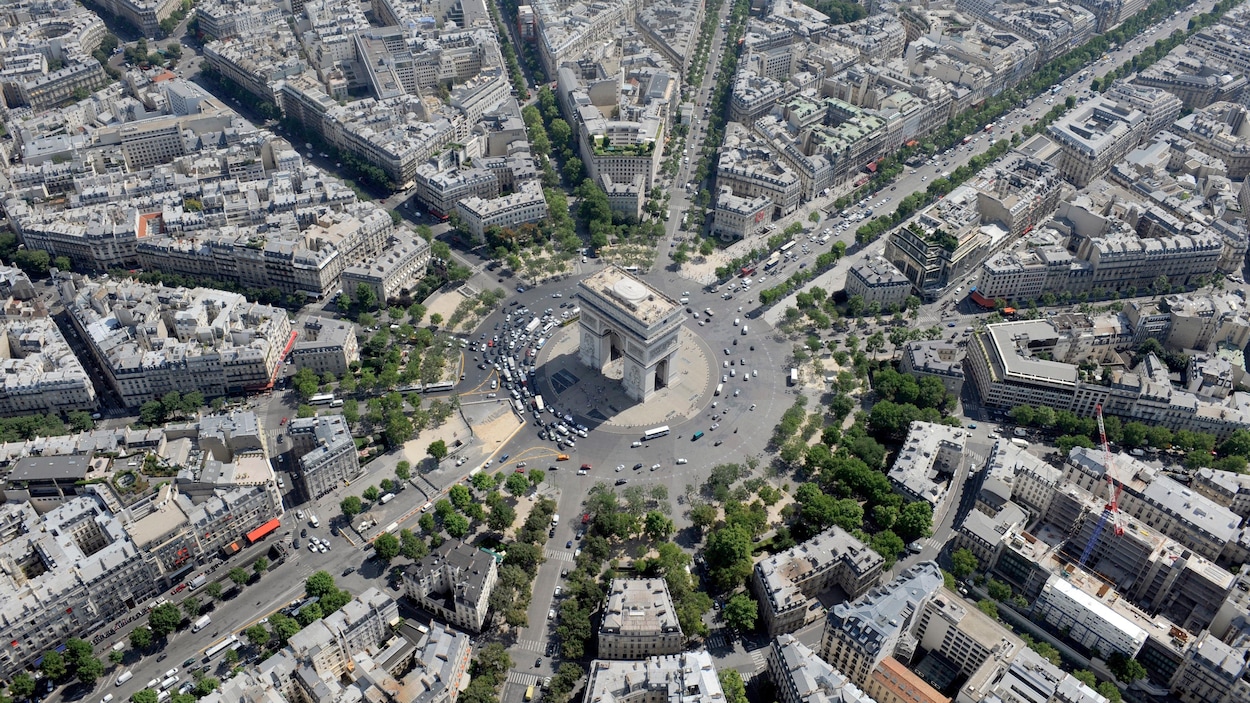Under the Second Empire, Napoleon III ordered baron Haussmann to plan a renovation of Paris as the city was very toxic, disease was spreading and it was even considered a hideous urban center. Dangerously high population density, crime and unrest were also considered side effects of the poor state of the city. At least that was the official narrative.
The idea was for Paris to become a more friendly city to its citizens, to the empire and also enlarge its borders by including some new arrondissements to make it to the total of 20 that we have today. The general spirit was that the city was in need of air and light. Napoleon III was obsessed with lighting the city. The living situation in the Île de la Cité was actually rather awful, roads were barely 5m wide, so even passing by with a carriage was a nightmare.
In 1852, regulations were passed for this and the works officially began in 1853.
Some of these new laws were that:
- The state decides the extent of the expropriations
- The owners of the homes are obliged to clean the exterior of their buildings and every 10 years make extensive work to refresh
- The buildings will be aligned to the roads which will in turn be aligned with the sewer system.
Further regulation later assigned the maximum height possible for buildings (increased from 17.55m to 20m) and essentially pushed for all buildings to have the same size, as well as specific regulation on the angles at the top.
This of course was not cheap and financial troubles arose within just 2 decades. The idea was to borrow money and then sell the plots to developers who would have to play by Haussmann's rules. I'm not sure how it ended up being financed, but the last project based on the Haussmann works was in 1927! The idea was that this would be a collaboration of State, the wealthy elite (bankers, businessmen) as well as private entrepreneurs.
Landmarks that we know of now were ordered to be built. The Opera by Garnier for example was built under this scheme.
Large boulevards to form an axis between Parisian gaps were built, such as Boulevard Sebastopol.
Large places (city squares) as well, but also reconstructing existing ones.
Train stations were built. Such as Gare de Lyon and Gare du Nord.
Green areas and parks were created, which was a rarity in Paris.
It is said that within the first 7 years of the project, there were 8,000 businesses involved in the transformation of Paris. That includes 31,000 builders, 5,000-8,000 carpenters, 3,500 roof constructors, 6,000 locksmiths, 600 painters and some other professionals. Around 55,000 people were occupied with these projects by 1860.
In short:
- Buildings that were considered unsafe or unaligned with the project were demolished.
- A drainage system was created, spanning 560km long.
- A new domestic water supply system was introduced.
- A new sewage system was created.
- Large boulevards were built.
- The Parisian arrondissements grew from 12 to 20 when the then villages on the periphery of the city, such as Montmarte and La Villete, were included in the city planning.
- A new road construction system was implemented.
- Large city squares and parks were created.
Of course, there were lots of social side effects and a lot of criticism going on at the time.
The concept of removing poverty from the lower ranks of Parisians was not accomplished as critics suggested that the poverty percentages were roughly the same. Essentially the more central arrondissements saw its population displaced to the new peripherical arrondissements, so we saw a drop in population in the 6th arrondissement but a rise in the 17th. Several similar examples exist.
There was also the concern of financing the project as well as criticism that the benefactors of this remodeling of the city was reduced to a few businesses.
Another criticism was that the whole project was to make the city more manageable by the Emperor, as in make it easier to move troops and police around the city and battle any civilian unrest, give more mobility and range for cannons if they had to be deployed against the citizens and other similar concerns on security.
One thing that is appreciated by all historians now is that the epidemics and the outbreaks of disease were now limited. Overall, Haussmann's transformation of Paris is something seen in a a positive light by Parisians and it is usually considered prestigious to live in an immeuble Hausmannien. Though older buildings that survived Haussmann and built by authentic 'Parisian stone' are also highly prestigious.
Some images that I found on the before and after:

 www.lefigaro.fr
This link above has 9 pictures with labels of what it is being displayed, I cannot copy them all here but some of the below are included.
www.lefigaro.fr
This link above has 9 pictures with labels of what it is being displayed, I cannot copy them all here but some of the below are included.


Île de la Cité 1855:

Île de la Cité 1857:

And this is of course the modern look only, unfortunately a before aerial shot is slightly impossible

At this point, I'd like to call on anyone who is familiar with the renovation of Paris to correct or add anything to what I've said. And I'd also like @loup99 or any other French members familiar with the history of the renovation, the social impact and the governance that lead to this, such as the bureaucracy involved that Loup mentioned in another thread.
The idea was for Paris to become a more friendly city to its citizens, to the empire and also enlarge its borders by including some new arrondissements to make it to the total of 20 that we have today. The general spirit was that the city was in need of air and light. Napoleon III was obsessed with lighting the city. The living situation in the Île de la Cité was actually rather awful, roads were barely 5m wide, so even passing by with a carriage was a nightmare.
In 1852, regulations were passed for this and the works officially began in 1853.
Some of these new laws were that:
- The state decides the extent of the expropriations
- The owners of the homes are obliged to clean the exterior of their buildings and every 10 years make extensive work to refresh
- The buildings will be aligned to the roads which will in turn be aligned with the sewer system.
Further regulation later assigned the maximum height possible for buildings (increased from 17.55m to 20m) and essentially pushed for all buildings to have the same size, as well as specific regulation on the angles at the top.
This of course was not cheap and financial troubles arose within just 2 decades. The idea was to borrow money and then sell the plots to developers who would have to play by Haussmann's rules. I'm not sure how it ended up being financed, but the last project based on the Haussmann works was in 1927! The idea was that this would be a collaboration of State, the wealthy elite (bankers, businessmen) as well as private entrepreneurs.
Landmarks that we know of now were ordered to be built. The Opera by Garnier for example was built under this scheme.
Large boulevards to form an axis between Parisian gaps were built, such as Boulevard Sebastopol.
Large places (city squares) as well, but also reconstructing existing ones.
Train stations were built. Such as Gare de Lyon and Gare du Nord.
Green areas and parks were created, which was a rarity in Paris.
It is said that within the first 7 years of the project, there were 8,000 businesses involved in the transformation of Paris. That includes 31,000 builders, 5,000-8,000 carpenters, 3,500 roof constructors, 6,000 locksmiths, 600 painters and some other professionals. Around 55,000 people were occupied with these projects by 1860.
In short:
- Buildings that were considered unsafe or unaligned with the project were demolished.
- A drainage system was created, spanning 560km long.
- A new domestic water supply system was introduced.
- A new sewage system was created.
- Large boulevards were built.
- The Parisian arrondissements grew from 12 to 20 when the then villages on the periphery of the city, such as Montmarte and La Villete, were included in the city planning.
- A new road construction system was implemented.
- Large city squares and parks were created.
Of course, there were lots of social side effects and a lot of criticism going on at the time.
The concept of removing poverty from the lower ranks of Parisians was not accomplished as critics suggested that the poverty percentages were roughly the same. Essentially the more central arrondissements saw its population displaced to the new peripherical arrondissements, so we saw a drop in population in the 6th arrondissement but a rise in the 17th. Several similar examples exist.
There was also the concern of financing the project as well as criticism that the benefactors of this remodeling of the city was reduced to a few businesses.
Another criticism was that the whole project was to make the city more manageable by the Emperor, as in make it easier to move troops and police around the city and battle any civilian unrest, give more mobility and range for cannons if they had to be deployed against the citizens and other similar concerns on security.
One thing that is appreciated by all historians now is that the epidemics and the outbreaks of disease were now limited. Overall, Haussmann's transformation of Paris is something seen in a a positive light by Parisians and it is usually considered prestigious to live in an immeuble Hausmannien. Though older buildings that survived Haussmann and built by authentic 'Parisian stone' are also highly prestigious.
Some images that I found on the before and after:

Paris avant et après Haussmann
LE FIGARO MAGAZINE - Difficile d'imaginer ce que serait Paris sans Haussmann. Jugé dévastateur par les uns, urbaniste de génie pour les autres, son oeuvre prête aujourd'hui encore à polémique. A vous de juger sur ces images. » LIRE - Comment Haussmann a rebâti Paris Léopold Sanchez (texte)...


Île de la Cité 1855:

Île de la Cité 1857:

And this is of course the modern look only, unfortunately a before aerial shot is slightly impossible

At this point, I'd like to call on anyone who is familiar with the renovation of Paris to correct or add anything to what I've said. And I'd also like @loup99 or any other French members familiar with the history of the renovation, the social impact and the governance that lead to this, such as the bureaucracy involved that Loup mentioned in another thread.
Last edited:
- 1
- 1






